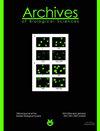Bacteriome composition analysis of selected mineral water occurrences in Serbia
IF 0.8
4区 生物学
Q4 BIOLOGY
引用次数: 1
Abstract
Bacterial metabarcoding analysis by 16S rDNA of five occurrences of mineral waters in Serbia (Torda, Slankamen Banja, Lomnicki Kiseljak, Velika Vrbnica and Obrenovacka Banja) indicated the presence of a high percentage of the Proteobacteria phylum, followed by the Bacteroidetes phylum. The families Rhodobacteraceae, Burkholderiaceae, Pseudomonadaceae, Methylophilaceae and Moraxellaceae were the most dominant in the bacterial flora of the selected occurrences, whereas the most represented genera were Acinetobacter, Pseudorhodobacter, Pseudomonas, Limnohabitans, Massilia, Limnobacter and Methylotenera. The presence of coliform bacteria was not detected. Alpha diversity analysis revealed that Slankamen Banja and Lomnicki Kiseljak were the richest of the selected occurrences, while the mineral waters of Torda, Velika Vrbnica and Obrenovacka Banja were characterized by similar diversity of bacterial communities determined by beta diversity analysis. Physical-chemical analysis revealed the value of total dissolved solids above 1 g/L, as well as elevated concentrations of some metals and non-metals. The research concluded that specific bacteria contribute to the development of biocorrosion and biofouling processes of water intake facilities. In addition, some of these bacteria might be potential indicators of the organic sources of pollution and/or biotechnological natural remediators in the treatment of contaminated waters.塞尔维亚选定矿泉水产地的细菌组成分析
利用16S rDNA对塞尔维亚5处矿泉水(Torda、Slankamen Banja、Lomnicki Kiseljak、Velika Vrbnica和Obrenovacka Banja)进行细菌元条形码分析,结果表明Proteobacteria门的存在率很高,其次是Bacteroidetes门。在选择的菌群中,Rhodobacteraceae、burkholderaceae、Pseudomonadaceae、Methylophilaceae和Moraxellaceae最占优势,而最具代表性的属为Acinetobacter、Pseudorhodobacter、Pseudomonas、Limnohabitans、Massilia、Limnobacter和Methylotenera。未检出大肠菌群。α多样性分析结果显示,Slankamen Banja和Lomnicki Kiseljak的细菌群落最丰富,而Torda、Velika Vrbnica和Obrenovacka Banja矿泉水的细菌群落多样性相似。理化分析显示,总溶解固形物超过1 g/L,一些金属和非金属的浓度也有所升高。研究认为,特定的细菌促进了取水设施的生物腐蚀和生物污染过程的发展。此外,其中一些细菌可能是有机污染源和/或生物技术天然修复剂处理受污染水的潜在指标。
本文章由计算机程序翻译,如有差异,请以英文原文为准。
求助全文
约1分钟内获得全文
求助全文
来源期刊
CiteScore
1.40
自引率
0.00%
发文量
25
审稿时长
3-8 weeks
期刊介绍:
The Archives of Biological Sciences is a multidisciplinary journal that covers original research in a wide range of subjects in life science, including biology, ecology, human biology and biomedical research.
The Archives of Biological Sciences features articles in genetics, botany and zoology (including higher and lower terrestrial and aquatic plants and animals, prokaryote biology, algology, mycology, entomology, etc.); biological systematics; evolution; biochemistry, molecular and cell biology, including all aspects of normal cell functioning, from embryonic to differentiated tissues and in different pathological states; physiology, including chronobiology, thermal biology, cryobiology; radiobiology; neurobiology; immunology, including human immunology; human biology, including the biological basis of specific human pathologies and disease management.

 求助内容:
求助内容: 应助结果提醒方式:
应助结果提醒方式:


